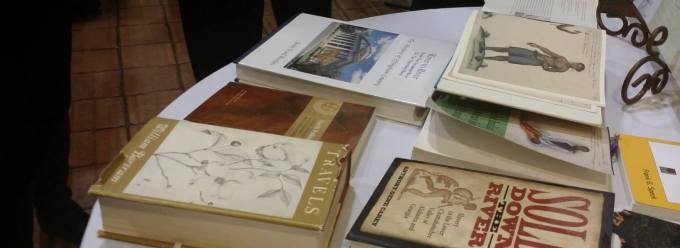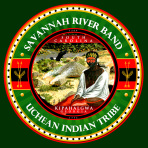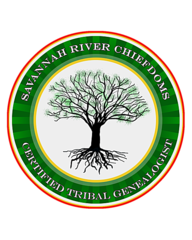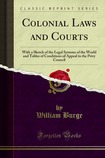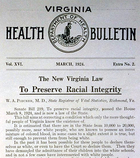Savannah River Chiefdoms
These online classes are Taught by Chief Langley, Tribal Historian Lecture, Professional Researcher, Expert Forensic Colonial historian, and Forensic Genealogist and is a leading authority on colonial statue laws and racial reclassification of American Indians living in South Carolina and Georgia in Southeast during Indian Slavery and those Natives who remain in their homelands after force removal. Chief Langley has spent over 10 years of studying and researching colonial laws, and Negro race relations as well as examing colonial court cases evolving racial reclassifications of Indians as Negro, colored, Mulatto, sometime white if they were living in a white community.
These courses not only presents the practical and theoretical aspects of conducting an educational practice in the events of colonial times., it also offers instruction on creative elements essential to successful casework. By working through actual case studies, students will learn innovative ways to conduct the investigative process by locating sources of information, analyzing data, and reporting findings.
Forensic genealogy establishes identity for legal purposes. The types of cases requiring a modern forensic genealogist’s expertise include
resolution of identifying, Ancestors land title and deeds, plantation types, owners, permits, slaves, The successful forensic genealogist also handles an expanded repertoire including
provenance, identity theft, historical fraud, and DNA identification of many kinds.
establishes identity for legal purposes. The types of cases requiring a modern forensic genealogist’s expertise include
resolution of identifying, Ancestors land title and deeds, plantation types, owners, permits, slaves, The successful forensic genealogist also handles an expanded repertoire including
provenance, identity theft, historical fraud, and DNA identification of many kinds.
Our students learn that his or her heritage case requires a specific investigative objective and a plan to reach that objective. As a result, data collected in the course of an
investigation must be analyzed for credibility and consistency. Students will learn the standards of practice that meet the ethical, legal, and documentary requirements of expert testimony. Even so, students discover that within this framework, a successful practitioner must often be highly creative in seeking novel ways to bring a difficult
case to a successful conclusion.
Fascinating casework such as the location of missing individuals is covered through examples selected from colonial case files. Approaches to handling the most challenging types of individuals are
discussed - people with racial reclassification base upon the color of their skin and not their ethnicity.
Students learn that a successful forensic genealogical approach depends on practical knowledge of colonial times, web presence, collaboration with other like minds, credentialing, and scope of
practice. this class is design to challenge you to maneuver around information roadblocks, to follow nearly invisible trails, to find clues that an unskilled observer would not notice, and to
second guess what really happened.
If you are interested in developing your genealogy skills from both practical and creative standpoints, this course is for you.
skills from both practical and creative standpoints, this course is for you.
Students are expected to participate in class discussions, group exercises and assignments.
Who Should Attend
Students who desire to search your family heritage.
Prerequisites
* Students should have completed open mind, patience and dedication.
* Familiarity with Evidence of family names and locations of where they have lived or might have lived.
Please Note:
Free People of Color – by County – 1790 Federal Census
A cross-reference using surnames, known names of Indian families, and historic Indian villages
In researching Indian ancestry, it’s important to note that for a variety of reasons in history (usually economic or socio-political), Indian people were often recorded as any race other than Indian. Sometimes “White,” other times “Black,” or “Negro,” and other times “Free Person of Color,” “Colored,” or “Mulatto.”
The entries have been taken from transcriptions of the 1790 Federal Census for several eastern North Carolina and South Carolina counties. The 1790 county/family names to the listed. Known Indian villages are given with modern-day equivalent town names, as well as any surnames that appear as “Other Free” on the 1790 census that are surnames also found amongst known Indians in documents (deeds, court records, etc.).
Please keep in mind that just because someone is of a particular surname that has at some point been associated with a particular tribe DOES NOT NECESSARILY mean that the person was of that tribe. It is necessary to establish a “preponderance of evidence” before making the assumption that someone was of a particular Indian nation.
Genealogy Research tip. the first record define of Mulatto by Chambers Cyclopedia is the spanish which is the offspring of an Indian and negro man or woman. later it became description the european and african admixture.
For the last 200 years numerous Indian descendants have been fighting a legal, and often racially charged, battle due to historical and modern-day race classification.
The dreaded historical beast of southeastern Indian communities that continues to rear it's ugly head is the fact that from the mid 1700's to after 1900 most Indian groups or individuals east of the
Mississippi were racially classified as "Mulatto." The reasons and justifications for this are rooted deeply in the history of southern slavery, land ownership, and political
power.
Prior to 1850 the federal census and most county tax books only distinguished 4 types of persons; free white males, free white females, free persons of color, and slaves. By the record keeping of the time Indians not taxed were not supposed to be recorded at all. These non-taxed Indians supposedly lived on reservations and therefore were not required to be subject to federal census or county tax recordings. However, the inhabitants of many state reservations and some federal Indian land grants were recorded on these documents.
In 1705 the Virginia Legislature passed into law that "the offspring of an Indian and a White is a Mulatto." This law went on to state that if the half-Indian 'mulatto' was to marry a white person then that 'mulatto' and his or her offspring were to be legally regarded as 'white' (this is undoubtedly where the notion that a person should be of at least ¼ blood to be considered an Indian arose). The Virginians were using the word 'mulatto' in its historical usage, from the root word 'mule', meaning any crossbreed. With the independent formation of the lower southern states, each state adopted racial classifications roughly equivalent to that of Virginia. Florida's official race laws stipulated that any mixed-blood person, whether of white/Negro, white/Indian, Indian/Negro, white/Hispanic, or whatever, were to be legally and socially classified as 'mulatto'.
Prior to 1850 federal censuses were performed primarily for tax and land ownership recording purposes, and most Indians were either not recorded, or included in the 'other free persons' or 'free persons of color' categories. Beginning in 1850, persons contracted to perform the federal census were encouraged to inquire as to person's self-identification due to the fear of "Light skinned Negroes trying to pass them selves off as whites or Indians." Given that there were only three available categories, white, black, or mulatto; that persons who appeared to be obviously mixed-blooded of any kind were to be listed as 'mulatto'; and that persons taxed could not be listed as 'Indian' (who were inherently non-taxed); it is not surprising that there were few Indians recorded east of the Mississippi from 1850 to 1900.
Colonial Court Records.
South Carolina
1731…Special meeting of the South Carolina House of Commons after a member had announced that “Free colored men with their white wives have immigrated from Virginia with the intention of settling on the Santee River.”, report of Governor Robert Johnson: “I have had them before me in council and upon examination find that they are not Negroes nor slaves but free people, that the father of them here is named Gideon Gibson and his father was also free…”
1753….. Will of Alexander Wood, of St. James Goose Creek Parish, Planter, to his half-breed Indian Slaves named Dukey Cox and George Cox, born of his Indian slave named Jenny, and Minerva Watkins, born of his Indian Slave named Moll, manumission upon his death
1794….Issac Linagear, Isaac Mitchell, Joanthan Price, Spencer Bolton, William N. Swett, and 29 other “free persons of color seek to repeal the Act for imposing a poll tax on all Free negroes, Mustees, and Mulattoes. They wish to support the government, but the poll tax caused great hardship among free women of color, especially widows with large families. Tax collectors hunted them down and extorted payments.”
(desire of legal system to lump all non-whites into one category)
25 JUL 1795…A South Carolinian advertised in the North Carolina Central and Fayetteville Gazette….”$10 Reward to deliver to the subscriber in Georgetown, a Mustie servant woman named Nancy Oxendine, she is a stout wench, of a light complexion about 30 years old. It is supposed she has been travels away by her brother and sister, the latter lives in Fayetteville.”
On March 20, 1924 the Virginia General Assembly passed two laws that had arisen out of contemporary concerns about eugenics and race: SB 219, entitled "The Racial Integrity Act[1]" and SB 281, "An ACT to provide for the sexual sterilization of inmates of State institutions in certain cases", henceforth referred to as "The Sterilization Act".
The Racial Integrity Act required that a racial description of every person be recorded at birth and divided society into only two classifications: white and colored (essentially all other, which included numerous American Indians). It defined race by the "one-drop rule", defining as "colored" persons with any African or Native American ancestry. It also expanded the scope of Virginia's ban on interracial marriage (anti-miscegenation law) by criminalizing all marriages between white persons and non-white persons. In 1967 the law was overturned by the United States Supreme Court in its ruling on Loving v. Virginia.
The Sterilization Act provided for compulsory sterilization of persons deemed to be "feebleminded," including the "insane, idiotic, imbecile, or epileptic."[2]
These two laws were Virginia's implementation of Harry Laughlin's "Model Eugenical Sterilization Law",[3] published two years earlier in 1922. The Sterilization Act was upheld by the U.S. Supreme Court in the case Buck v. Bell 274 U.S. 200 (1927). This had appealed the order for compulsory sterilization of Carrie Buck, who was an inmate in the Virginia State Colony for Epileptics and Feebleminded, and her daughter and mother.
Together these laws implemented the practice of "scientific eugenics" in Virginia
Client Reviews
chief Langley I want to say thank you for the work that you are doing. All the info. is a great help to all. Hats off to you my brother.(again thk u)~~~!!!
Laval Lev Malachiposted toLonzado Langley
Just finished reviewing the Uchean Tribe website and I am highly impressed with all the detailed information provided. Wow you do great professional work - stay the straight course because only success is in your future. You are an Icon and a credit to your people.
Najla Lylesposted toLonzado Langley
Thank you. Your work is very valuable to my family. I look forward to working with you.
Dalton Terrelleposted toLonzado Langley
Halito Chief Langley, love what you are doing here. My family is one of many Aboriginal families who are renegade Indians. We know we are Mississippi Choctaw our elder spoke Chahta as do I but the
names are lost. I'm trying to pass the 1800s. You have given me many new ideas. To all that you are doing for the Aborigines and the Indigenous people of America, Yokoke my brother
DrMumbo Jumboposted toLonzado Langley
Halito Chief Langley, Thank you for accepting my friend request and all of the work that you're doing for indigenous Americans!
William Bellposted toLonzado Langley
Thank you for the accept Bro Lonzado Langley, I am definitely learning a lot from your instructions to search census records etc.
Beverly A Harperposted toLonzado Langley
Luv all your post and thanks for accepting my friend request, keep putting the message out there.
Seta Aset
this is a beautiful thing you all are doing. This says a lot about us as true, loving people
Jena Jones
Lonzado...I had to reach out to you and say thank you, thank you, thank you for sharing the link with me. I listened to it in it's entirety (replaying some parts of it). The information you share is
amazing and I am so glad our paths have crossed.
There's a saying that goes something like "When the student is ready, the teacher appears." I don't know how (other than by divine appointment) our paths crossed, but I have a feeling I am to learn
much from/through you and for that, I am excited.
I have sooo many questions but I think I need to calm down and get them into some sort of intelligible order so I will not sound like some sort of babbling dumb-dumb.
I'll be in touch.
...Jena
Kayla Kiara
i have had some improvements on my genealogy since your class
Slojamoz Oz
Chief, AWESOME conference call! U are SO INSPIRING! Thank u so much! while researching, i came across this u.s. doc, were they admit to failure & negligence of Col. Ward for not adding Ms Choctaw
to rolls of which they applied after which, they took & sold the land. thought i'd share!
Hosea Dixon
Chief Langley, thank you very much for this information. I am trying to decipher it now and comprehend it. My initial thoughts are that these maybe different sets of people. I am seeing new names. I
am up for this task. I am very grateful for your guidance. I am willing and ready to learn everything that you are willing to share with me. I am going to establish my family(tribe) in our rightful
place. Thank you very much. much respect chief
